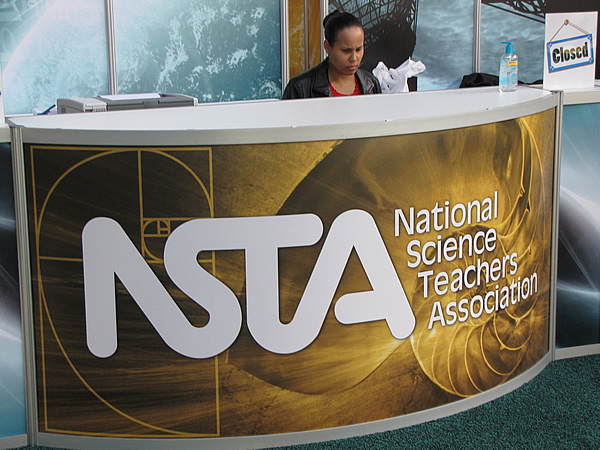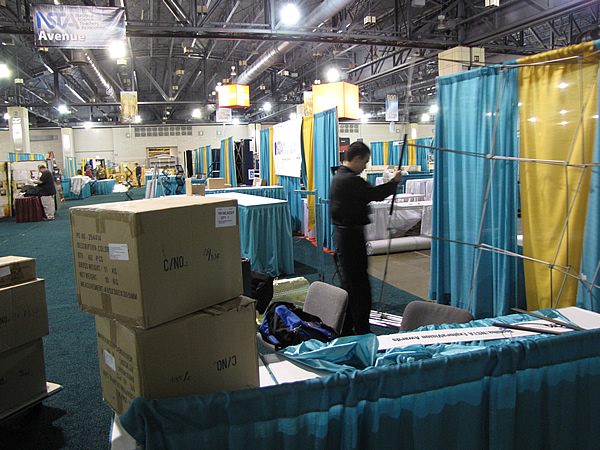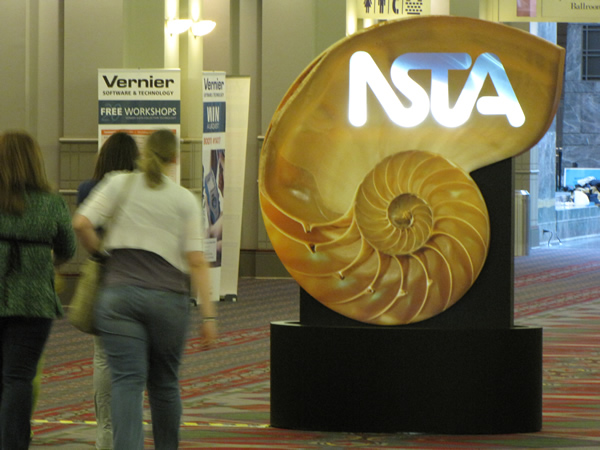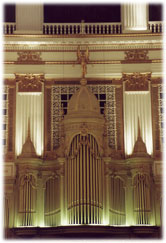The Science Store is bustling
By Lynn Petrinjak
Posted on 2010-03-18
There’s still a few minutes before the exhibit hall opens, but the Science Store has been busy for quite a while this morning.
The Science Store has new look this year. If you’re on site, check out the Picture Perfect Science Lessons, the science T-shirts, and of course all the great books. I heard several folks discussing their favorite titles. One teacher was telling a friend/colleague how she uses Everyday Science Mysteries with her students.
I’ve also seen a lot of warm greetings as attendees reconnect with old acquaintances. I can’t how many times I’ve heard, “I didn’t know you were going to be here!”
Early enthusiasm evident
By Lynn Petrinjak
Posted on 2010-03-18
I was talking to a first time attendee on the trolley from the hotel to the convention center this morning. Cecelia Dygdon told me the web site was overwhelming, she found a lot of sessions she wanted to attend, but didn’t immediately realize they were spread out between the convention center and a couple nearby hotels. She was headed to the first time attendee meeting, so I’m sure she’ll get some great advice from the folks there.

Photo Credit: Creative Commons Seashells are multifunctional. In addition to housing and protecting an organisim, they can be used to spark scientific curiosity and literacy.
Cecelia describes herself as a career-changer, having worked in industry for several years after teaching for a short time after college. She’s now a high school chemistry and physical science teacher in the Chicago, Illinois area. She says she came to the conference because “it’s good for me to hone my skills. I really need to relearn things; not just content but pedagogy.” Cecelia is in the Department of Education’s ACTS program.
The first session I planned to attend was packed to overflowing. I couldn’t even get close to the door! Apparently a lot of educators got up this morning with Differentiated Science Inquiry on their minds.
Good thing I had another session in mind as an alternative, Connect the Dots to Help Students Develop Literacy Skills Along with Science Content. Karen Ostlund shared how she has incorporated literacy into scientific exploration for sea shells. Hands-on activities for the participants, and examples of student work illustrated her methods well. Interesting fact I learned in the session this morning—shell colors are like a “memory,” recording changes to the mollusk’s environment.
I was talking to a first time attendee on the trolley from the hotel to the convention center this morning. Cecelia Dygdon told me the web site was overwhelming, she found a lot of sessions she wanted to attend, but didn’t immediately realize they were spread out between the convention center and a couple nearby hotels. She was headed to the first time attendee meeting, so I’m sure she’ll get some great advice from the folks there.
Among friends
By Debra Shapiro
Posted on 2010-03-17
The great thing about traveling to an NSTA conference is that almost immediately you find yourself among friends. When I arrived at the train station, I wasn’t sure if I would know anyone waiting in line. That can be a little unnerving. However …
 Not only did I immediately spot two of my colleagues, but we also had a nice chat with Christopher DiScenza of the American Physical Society, who was waiting in line with us. I soon felt right at home, as NSTA staff are often in contact with the APS staff. And when Christopher mentioned his office is in College Park, Maryland, I replied that the University of Maryland, College Park, is my alma mater. Small world!
Not only did I immediately spot two of my colleagues, but we also had a nice chat with Christopher DiScenza of the American Physical Society, who was waiting in line with us. I soon felt right at home, as NSTA staff are often in contact with the APS staff. And when Christopher mentioned his office is in College Park, Maryland, I replied that the University of Maryland, College Park, is my alma mater. Small world!
I’m looking forward to connecting with more familiar faces and names here in Philly. I know these “reunions” will happen.
The great thing about traveling to an NSTA conference is that almost immediately you find yourself among friends. When I arrived at the train station, I wasn’t sure if I would know anyone waiting in line. That can be a little unnerving. However …
The calm before
By NSTA Web Director
Posted on 2010-03-17
Things are quiet for now at the registration area in Philadelphia (noon on Wednesday—attendee registration opens at 5:00).

But things are buzzing in the Exhibit Hall. An NSTA staffer called it “sausage being made.” I’ve attended quite a few NSTA conferences, but never arrived early enough to see the Exhibit Hall being assembled. Quite a sight.

While many exhibitors have been hard at work all day, attendees are just starting to arrive. It’s not too late for you to decide to join them!

Can't wait for the exhibits!
By Lauren Jonas, NSTA Assistant Executive Director
Posted on 2010-03-17
 Walking through the Exhibit Hall, watching it get set up, is exciting. Pretty soon the rafts of building materials, strings of lights, and yards of material will be booths displaying all sorts of incredible science-teaching resources. The NSTA Avenue will be ready for members, where they can learn about their benefits, meet the staff, and discuss the issues important to them. Want to suggest something to NSTA? That will be the place to do it! And the exhibits are the best source of inspiration and goodies. Learn to keep a science notebook, browse through books, build a circuit, or even play with robots! And who doesn’t love stocking up on all the freebies—seed packets, pens, rocks—usually you end up with plenty to share with your whole science department.
Walking through the Exhibit Hall, watching it get set up, is exciting. Pretty soon the rafts of building materials, strings of lights, and yards of material will be booths displaying all sorts of incredible science-teaching resources. The NSTA Avenue will be ready for members, where they can learn about their benefits, meet the staff, and discuss the issues important to them. Want to suggest something to NSTA? That will be the place to do it! And the exhibits are the best source of inspiration and goodies. Learn to keep a science notebook, browse through books, build a circuit, or even play with robots! And who doesn’t love stocking up on all the freebies—seed packets, pens, rocks—usually you end up with plenty to share with your whole science department.
Taking the train
By Lynn Petrinjak
Posted on 2010-03-17
It’s time to head for the train station and get on my way to the 2010 National Conference on Science Education in Philadelphia. I’ve created a schedule for myself using the online Personal Scheduler (with a couple promising sessions/workshops selected for most time slots—just in case) and printed a hard copy (also just in case). My rolling bag is packed (comfortable shoes, notebook, pens, camera, etc.) and it’s time to head to the train station. I hope I’m not forgetting anything—I forgot to pack socks when we were in Boston two years ago. How does a person forget socks?
In addition to checking out the exhibit hall and sessions and talking to as many science eduation pros as possible, I have a personal goal for myself—get a Phillly cheesesteak South Jersey style !
It’s time to head for the train station and get on my way to the 2010 National Conference on Science Education in Philadelphia. I’ve created a schedule for myself using the online Personal Scheduler (with a couple promising sessions/workshops selected for most time slots—just in case) and printed a hard copy (also just in case). My rolling bag is packed (comfortable shoes, notebook, pens, camera, etc.) and it’s time to head to the train station. I hope I’m not forgetting anything—I forgot to pack socks when we were in Boston two years ago.
Take a musical break
By Mary Bigelow
Posted on 2010-03-17
 Catty-corner from the Mariott Hotel in Philadelphia is a national musical treasure: the Wanamaker organ (yes, the store is a Macy’s now). This is the largest operational pipe organ in the world. At the Friends of the Wanamaker Organ website, you can read about its history and specifications as well as listen to a sound clip. The photo (from the Friends’ site) shows the organ in the 7-story court in the store. The concerts are free. Revive your soul and spirit:
Catty-corner from the Mariott Hotel in Philadelphia is a national musical treasure: the Wanamaker organ (yes, the store is a Macy’s now). This is the largest operational pipe organ in the world. At the Friends of the Wanamaker Organ website, you can read about its history and specifications as well as listen to a sound clip. The photo (from the Friends’ site) shows the organ in the 7-story court in the store. The concerts are free. Revive your soul and spirit:
- Monday-Saturday 12pm
- Monday, Tuesday, Thursday, Saturday 5:30pm
- Wednesday, Friday 7pm
My fondest childhood memories include riding the train to Philadelphia to hear the organ. I’ll relive those memories this week!
 Catty-corner from the Mariott Hotel in Philadelphia is a national musical treasure: the Wanamaker organ (yes, the store is a Macy’s now). This is the largest operational pipe organ in the world. At the Friends of the Wanamaker Organ website, you can read about its history and specifications as well as listen to a sound clip.
Catty-corner from the Mariott Hotel in Philadelphia is a national musical treasure: the Wanamaker organ (yes, the store is a Macy’s now). This is the largest operational pipe organ in the world. At the Friends of the Wanamaker Organ website, you can read about its history and specifications as well as listen to a sound clip.
Happy St. Patrick's Day
By Lauren Jonas, NSTA Assistant Executive Director
Posted on 2010-03-16
What’s a good Irish Science Teacher to do in Philly on St. Patrick’s Day? Judging by the amount of green I’m seeing around town today, there’s plenty! Start your day off with a smile by taking a virtual field trip to Dublin’s new National Leprechaun Museum. Or if you’re looking for a bit of Ireland right here in Philly, go to Fado’s Irish Pub across from City Hall for free pancakes before 11:00 a.m. You’ll need to walk them off of course, so try heading to the Morris Arboretum. Rumor has it there are shamrocks tucked in among its 92 acres, complete with babbling brooks. If you don’t find them, you can still have a green adventure—visit the wetlands, stroll through the meadow gardens, or “soar into the trees on a spectacular 40-foot high walkway on Out on a Limb—a Tree Adventure exhibit.”
 If you prefer the fauna to the flora, go green at the Philadelphia Zoo. Today is “Walmart Wednesday,” and admission and parking are discounted by 60%. See the animals, learn about conservation, or take a ride on my personal favorite—the Amazon Rainforest Carousel.
If you prefer the fauna to the flora, go green at the Philadelphia Zoo. Today is “Walmart Wednesday,” and admission and parking are discounted by 60%. See the animals, learn about conservation, or take a ride on my personal favorite—the Amazon Rainforest Carousel.
If you’re stuck inside and love a parade, you can watch an encore of the Philadelphia St. Patrick’s Day Parade. It will air on the local CBS3 station from 9:00 a.m. to noon and again on CW Philly 57, from 2:00 p.m. to 5:00 p.m. This is the 240th year it’s been held!
And finally, if you’ve always heard that “Guinness is good for you,” you may want to find out for yourself. Apparently the Irish Times–Philadelphia, in the heart of Queen Village, was voted one of the Best Pints of Guinness in the city.
What’s a good Irish Science Teacher to do in Philly on St. Patrick’s Day? Judging by the amount of green I’m seeing around town today, there’s plenty! Start your day off with a smile by taking a virtual field trip to Dublin’s new National Leprechaun Museum. Or if you’re looking for a bit of Ireland right here in Philly, go to Fado’s Irish Pub across from City Hall for free pancakes before 11:00 a.m. You’ll need to walk them off of course, so try heading to the Morris Arboretum.
Three Creative, Committed, and Caring NSTA Teacher Awardees
By Debra Shapiro
Posted on 2010-03-16
Sometimes during the publishing process, we find we must trim some of our Reports stories to fit the alloted space in print. This was the case for “NSTA Awardees: Creative, Committed, and Caring” from our March 2010 issue. The good news is our online outlets allow us to share everything with you—no trimming necessary!
With that in mind, meet three 2010 NSTA Teacher Awardees whose work we had wanted to highlight in the March piece. (And learn more about NSTA’s Teacher Awards here. You too could be in print or online in 2011!)
Robert H. Carleton Award
Arthur Eisenkraft, Distinguished Professor of Science Education
University of Massachusetts, Boston, Massachusetts
2000–2001 NSTA President Arthur Eisenkraft co-created three NSTA recognition programs: the Toshiba/NSTA ExploraVision Awards, the Duracell Scholarship Competition, and the Toyota TAPESTRY Grants for Teachers. Not only have these programs “benefitted thousands of teachers and students,” but they also “brought recognition and financial gain to NSTA,” observes 2001–2002 NSTA President and nominator Harold Pratt.
Eisenkraft’s service to the profession includes helping to develop the National Science Education Standards, creating the Active Physics and Active Chemistry curricula, and working on the committee to develop the National Assessment of Educational Progress for the years 2009–2019.
Shell Science Teaching Award
Tamica Stubbs, Biology and Research Teacher
E.E. Waddell High School, Charlotte, North Carolina
One of Stubbs’s students says, “She has taught me biology, AP biology, nanotechnology, biotechnology, and biomolecular modeling via proteins—but more than that, she has taught me what it means to have a teacher [who] believes in her students and will do anything in her power to help them succeed.”
Stubbs has established science clubs and mentored students in projects that led to her school entering district, state, and county competitions. Her grant writing skills and community networking activities have brought a range of new equipment to her classroom, inspiring even students disinterested in science to become researchers and investigators.
Bio-Rad Biotechnology Explorer Award
(New Award for 2010)
Jennifer Hand, Science Teacher
Cairo High School, Cairo, Georgia
With funds from a local grant, Hand incorporated biotechnology into her classroom using Bio-Rad’s Crime Scene Investigator kits and DNA fingerprinting equipment. She enlisted the help of a molecular geneticist to train her and her colleagues in using the equipment and doing the fingerprinting. As a result, she says, more of her students at all levels are passing the science portion of the high school graduation exam, and they look forward to their science classes “instead of dreading the doldrums of yet another worksheet.”
One of her students remarked, “I see this kind of stuff on television, so to be able to do this in my 10th-grade biology class was awesome.”
Read about the other 2010 awardees.
Sometimes during the publishing process, we find we must trim some of our Reports stories to fit the alloted space in print. This was the case for “NSTA Awardees: Creative, Committed, and Caring” from our March 2010 issue. The good news is our online outlets allow us to share everything with you—no trimming necessary!
Science learning in six domains
By Lynn Petrinjak
Posted on 2010-03-16
In the March issue of NSTA Reports, Dr. Robert Yager shares his perspective on the six domains for teaching and assessing science learning in the Educated Opinions column.
“A View of the Importance of Six Domains for Teaching and Assessing Science Learning”
By Robert Yager
Four years ago, the National Science Education Standards (NSES) resulted from the collective brainpower of thousands of concerned science educators from around the world at a cost of $7 million. Sadly, little has changed since then. Alan McCormack, 2010–2011 NSTA President, and I have proposed six “domains” as a way to get the attention of teachers and students and to encourage them to experiment with school science programs as they try to move to the “more emphasis” conditions central to the NSES. These “domains” can be used to explain how the eight facets of science content (as defined by the standards) affect people’s everyday lives. Teachers, schools, and state departments of education rarely focus on all eight when considering the science curriculum and how it should look and what teachers need to do for the reforms to succeed. It is rare to find state standards that even mention these major changes. It is important for all science educators to identify the specific features that indicate real changes central to current reform efforts. Read the full article here.
What do you think: Can the six domains improve science learning in your classroom/school/district? Why or why not?
In the March issue of NSTA Reports, Dr. Robert Yager shares his perspective on the six domains for teaching and assessing science learning in the Educated Opinions column.
“A View of the Importance of Six Domains for Teaching and Assessing Science Learning”
By Robert Yager



